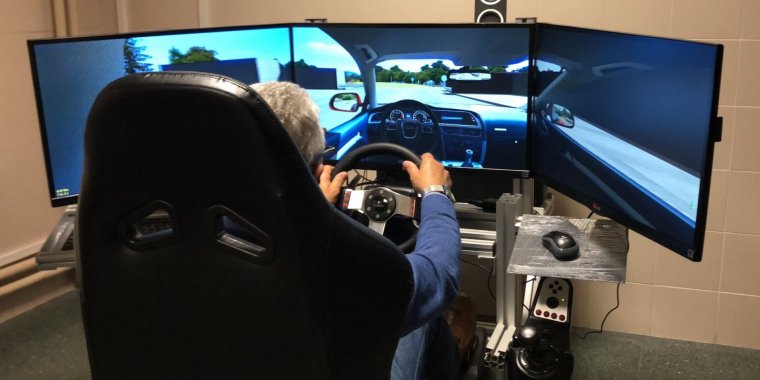| News / Science News |
Scientists determine the visual parameters that could predict safe driving performance among older drivers
A team of scientists from the Department of Optics of the University of Granada (UGR) has analysed which visual parameters can predict safe driving performance among older drivers.

The driving simulator used by UGR researchers in the study. Photo: University of Granada
The results of their study indicate that the level of intraocular scattering, which is related to glare sensitivity, could help predict driving performance in people aged over 55 years.
As a result of the ageing process, a series of physiological changes take place that can sometimes evolve into pathological alterations such as senile cataracts, and which can significantly affect drivers’ vision (decreased visual acuity, loss of contrast, and glare sensitivity).
The present study was carried out by researcher Sonia Ortiz Peregrina and directed by Dr Rosario González Anera and Dr Carolina Ortiz Herrera.
A total of 20 drivers over the age of 55 were included in the study sample, 10 of whom were diagnosed with bilateral cataracts. All of the participants underwent a series of tests to analyse their level of visual function, and their driving ability was evaluated using a driving simulator.
The results showed that driving performance among subjects diagnosed with cataracts was significantly worse. These subjects tended to drive at lower speeds, possibly as a compensatory mechanism for their visual impairment, which meant they required 11.7% more time to complete the test circuit.
This group also presented greater difficulty with lane maintenance: the standard deviation of the lateral position (of the vehicle relative to the lane) increased significantly among these subjects, being 21.3% greater than that of the control group. This means that these drivers travelled a greater distance while invading the opposite lane.
The results of the study also established which visual parameters are correlated with driving or, more specifically, with the general driving performance index.
The researchers identified that a higher Objective Scatter Index (OSI), which quantifies the level of intraocular scattering, negatively affects driving performance.
This index, frequently used as an objective measure of an individual’s quality of vision, was found to be 3.5 times higher in the cataract group.
In fact, the regression analysis showed that the OSI is a good predictor of driving, this parameter being able to explain 51.3% of the variability in the general driving performance index of older people.
In light of this work, the UGR researchers concluded that cataracts can significantly impair some aspects of simulated driving, so it could be useful to use other tests in addition to the standardized measurement of visual acuity.
For example, it could be of value to evaluate the level of intraocular scattering, which increases significantly in line with ageing and even more so in the case of drivers with cataracts.
In this way, the OSI could constitute a good predictor of driving performance in older people and may help determine the point at which visual impairment begins to affect the ability to drive safely. (University of Granada)





